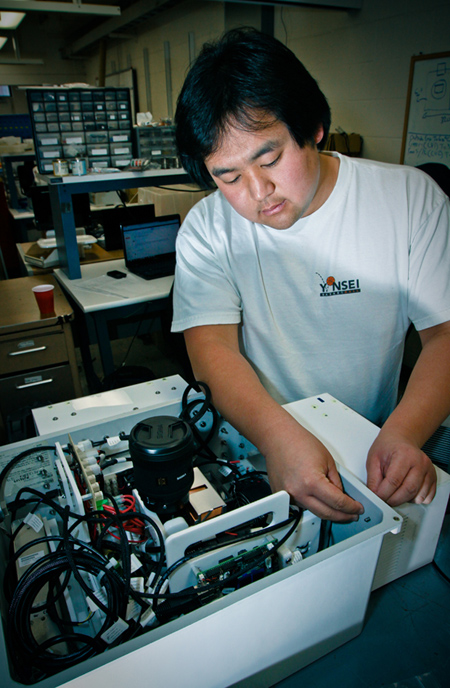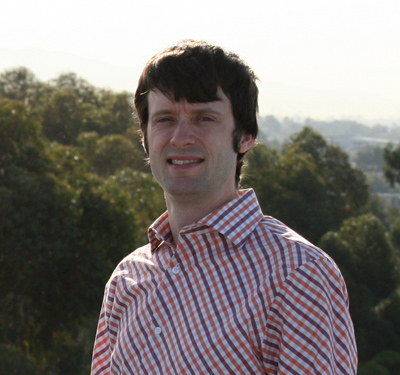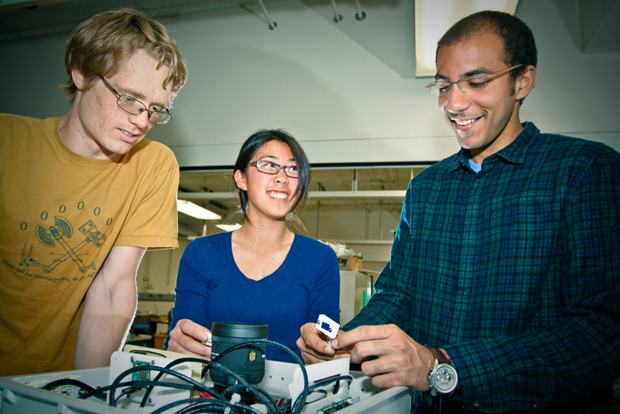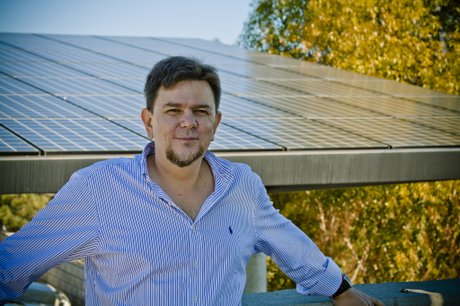President Obama Visits Solar Power Plant Using Technology Developed by UC San Diego Engineers
By:
- Ioana Patringenaru
Published Date
By:
- Ioana Patringenaru
Share This:
Article Content
Article Content
When President Obama visited the Copper Mountain Solar 1 Facility in Nevada Wednesday, he got a first-hand look at the first large-scale solar facility equipped with solar forecasting devices called sky imagers. The devices are powered by sophisticated algorithms, which were developed by researchers at the University of California San Diego. The technology was funded by Sanyo Electric Corp., now Panasonic, the Department of Energy, California Energy Commission and California Public Utilities Commission.

Scott Kato, a mechanical engineering major, works on a sky imager.
Copper Mountain Solar 1 is the largest photovoltaic power plant in the country, and is operated by San Diego-based Sempra U.S. Gas & Power. Sky imagers are essentially fish-eye lenses that capture a 360-degree view of the horizon and generate a 3-D model of the clouds they observe. The devices are connected to a sophisticated forecasting system that uses what it observes to predict solar power output in 15-minute increments.
Sky imagers, and their algorithms, are the brain child of Jan Kleissl, an environmental engineering professor at the Jacobs School of Engineering at UC San Diego. His research, and solar forecasting at UC San Diego, received a boost earlier this month with a $1.5 million grant from the California Public Utilities Commission. The grant funds research to refine forecasting methods and work with San Diego Gas & Electric to help integrate solar power into the energy grid. Kleissl is the principal investigator on the grant with Carlos Coimbra, also a professor of environmental engineering at the Jacobs School. Their work could generate substantial savings for utility companies.

Jan Kleissl, a professor of environmental engineering at the Jacobs School is on of the lead PI on the grant.
In addition to the CPUC funding, the project is receiving matching funds from SDG&E, the National Renewable Energy Laboratory, the California Energy Commission and the Department of Energy.
"As California continues to integrate higher amounts of solar energy into the grid, demonstration projects like these will maximize the value of solar energy by providing predictable generation profiles that grid operators can rely on," said CPUC President Michael R. Peevey.
See how algorithms developed by Ricardo Marquez of Prof. Carlos Coimbra's Solar Forecasting Group using a conventional, low resolution sky imager forecast ground irradiance (red line) 5 minutes ahead of time, and how the forecast compares with the actual irradiance measurements (grey area).
The two-year grant is the first received by the Center of Excellence for Renewable Resources and Integration at the Jacobs School of Engineering at UC San Diego. The center, which became an official entity on Feb. 14, is led by Coimbra and Kleissl. The two researchers and their respective teams will work together to develop comprehensive forecast models that predict solar power output, based on how much sunlight can be found at a specific location—and how it fluctuates. The researchers’ sensor network now extends beyond San Diego to include many sites along the Pacific Rim, from Bellingham, Wash., to Oahu, Hawaii.
So far, utilities have been struggling to integrate solar power into their energy portfolios because the output of energy generated by the sun is highly variable. For example, when the marine layer rolls in, output drops to about 50 percent of its full potential. When it evaporates, output goes back up to 100 percent. Researchers hope to minimize the uncertainty by helping utilities predict and manage these fluctuations through solar forecasting.
Significant savings

From left: graduate student Ben Kurtz, Amy Chiang, a senior, and graduate student Mohamed Ghonima.
Researchers said they hope their work will allow utilities to generate significant savings. To make up for the variability in output from renewable sources of power, utilities often run one megawatt of back-up power from traditional sources for every megawatt of power from alternative sources on the grid. With a better understanding of how much and when power fluctuates, utilities will be able to schedule back-up power more accurately, saving as much as 50 percent of their operational costs in the process, Kleissl said.
Research work

Carlos Coimbra, a professor of environmental engineering is the other PI on the CPUC grant.
Researchers will focus on several areas of a few square miles each in San Diego’s power grid, called feeders, which are home to many photovoltaic panels. They will model, in real-time, power output from the areas. Then they will use the model to forecast output, looking anywhere from 15 minutes ahead to 36 hours ahead. Ultimately, they hope to assemble a best practices manual for solar forecasting in utility operations.
For this project, Kleissl and colleagues will deploy for the first time a new generation of sky imagers that were conceived as prototypes and assembled at the Jacobs School of Engineering, based on decades of work at the UC San Diego Scripps Institution of Oceanography. The devices capture comprehensive, high-resolution images of cloud conditions and solar irradiance, which researchers then use for modeling and short-term forecasting. The new devices are more accurate. They can also be more easily customized, as researchers now have control over every component.
The Center of Excellence for Renewable Resources and Integration
SolAspect's high-definition cloud tracker showing cirrus, nimbus and cumulus clouds and their effects on direct normal irradiance at the ground level.
This grant is only the first in a range of projects at the Center of Excellence for Renewable Resources and Integration, which is part of the Center for Energy Research at the Jacobs School of Engineering. “We have very high hopes for the center,” said Center Co-director Coimbra.
He plans to build a control room that will pool data from all of the observation centers equipped with his devices across California, in Merced, Davis, Berkeley, San Diego and Washington State, among others. His laboratory also receives data from Oahu. The more information, the better, Coimbra explained. “This is the mother of all chaotic systems,” he said. “It’s a very complicated problem.”
In addition to perfecting forecasting methods, the center also will focus on workforce development. There is no place in the world that is currently training workers in the disciplines of solar forecasting, Coimbra said. The center will equip individuals with graduate degrees with an understanding of grid integration, renewable energy, machine learning and meteorology, as well as grid operations.
“We are hoping that it will raise the profile of alternative energy research here at UC San Diego even further,” Kleissl said.
Share This:
You May Also Like
Stay in the Know
Keep up with all the latest from UC San Diego. Subscribe to the newsletter today.




